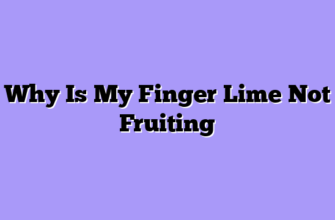Picture this: you’ve just invested thousands of dollars in finger lime saplings, spent weeks preparing the perfect planting spots, and confidently placed them in the sunniest corner of your property. After all, citrus trees love full sun, right? Wrong. Dead wrong. And boy, did I learn this lesson the expensive way.
Three years ago, I was standing in what looked like a finger lime graveyard. Twelve beautiful saplings, each costing me nearly $80, were slowly cooking to death under the relentless California sun. Their leaves were crispy brown, branches were dropping like autumn confetti, and I was beginning to question my sanity for venturing into exotic citrus farming. That’s when my neighbor, an old-timer who’d been growing unusual fruits since before I was born, wandered over with a knowing shake of his head.
“Son,” he said, pointing at my struggling trees, “you’re treating them like oranges when they want to be treated like forest dwellers.” That single comment changed everything I thought I knew about finger lime cultivation and saved what remained of my investment.
The Great Sun Misconception: Why I Got It So Wrong
Here’s the thing that trips up most new finger lime growers – we assume all citrus trees have the same light requirements. It makes perfect sense, doesn’t it? Oranges, lemons, grapefruits – they all bask in full sun and produce abundantly. So naturally, finger limes should follow the same rules. Except they don’t, and this assumption has probably killed more finger lime trees than any disease or pest.
Finger limes, or Citrus australasica if you want to get technical, are native to the subtropical rainforests of eastern Australia. Think about that for a moment. Rainforests. Not sun-baked citrus groves, not Mediterranean hillsides, but the filtered, dappled light of forest understories. These trees evolved to thrive in what I now call “bright shade” – enough light to photosynthesize efficiently, but protected from the harsh, direct rays that can literally burn them to a crisp.

The wake-up call came during a particularly brutal heat wave when temperatures soared to 105°F. I lost four trees in three days. That’s when I finally swallowed my pride and started researching their native habitat. What I discovered completely revolutionized my approach to finger lime cultivation.
Finding the Sweet Spot: My Journey to Perfect Light Conditions
After my spectacular failure, I became obsessed with recreating the perfect growing conditions for finger limes. I spent countless hours studying their natural environment, reading research papers, and most importantly, experimenting in my own grove. What I learned could save you years of heartache and thousands of dollars in replacement trees.
The ideal light condition for finger limes is what I call “morning sun, afternoon shade.” They need bright, indirect light for most of the day, with perhaps 4-6 hours of gentle morning sun. Think of it like this: if regular citrus trees are sun worshippers lying on a beach chair, finger limes are more like café dwellers who prefer a table by the window with an umbrella overhead.
Here’s my step-by-step approach to creating the perfect light environment:
- Site Selection: Choose locations that receive morning sun (6 AM to 11 AM) but get natural shade during the hottest part of the day
- Shade Cloth Installation: For areas with too much sun exposure, install 30-50% shade cloth 8-10 feet above the trees
- Companion Planting: Use taller plants or trellises to create natural windbreaks and partial shade
- Microclimate Creation: Position trees near walls or structures that provide afternoon shade while reflecting morning light
- Seasonal Adjustments: Move potted trees or adjust shade structures based on seasonal sun patterns
The transformation was remarkable. Within six months of relocating my surviving trees to partially shaded areas, I saw explosive growth. New shoots emerged, leaves regained their vibrant green color, and for the first time, I spotted tiny flower buds forming.
Light Requirements by Growth Stage
| Growth Stage | Light Needs | Duration | Special Considerations |
|---|---|---|---|
| Seedling (0-1 year) | Bright indirect light | All day | Too much sun causes permanent damage |
| Young Tree (1-3 years) | Morning sun, afternoon shade | 4-6 hours direct | Critical establishment period |
| Mature Tree (3+ years) | Filtered sun with protection | 6-8 hours total | Can tolerate more sun but still needs protection |
| Flowering/Fruiting | Consistent bright light | All day | Avoid stress during reproductive phases |
The Practical Reality: Making It Work in Your Space
Now, you might be thinking, “This sounds complicated. Do I really need to build some elaborate shade structure for a few fruit trees?” The honest answer is: it depends on your climate and existing landscape. I’ve learned that finger lime cultivation is all about working with what you’ve got and getting creative with solutions.
In my experience, the easiest approach is strategic placement rather than elaborate construction. I’ve had tremendous success growing finger limes:
- Under existing fruit trees: My best-producing finger lime grows beneath a mature avocado tree
- On the north side of buildings: Gets bright light without harsh afternoon sun
- Near tall shrubs or bamboo: Natural windbreaks that filter intense light
- In large containers: Allows for seasonal repositioning based on sun patterns
- Under pergolas or arbors: Existing structures that provide perfect dappled light
The container approach has become my favorite for new growers. I use 25-gallon containers that allow me to move trees seasonally. During our mild winters, they get more direct sun. Come summer, I roll them to shadier spots. It’s like having a mobile orchard that adapts to Mother Nature’s moods.
One of my most successful finger lime installations happened by accident. I had temporarily placed a young tree next to my greenhouse while deciding on a permanent location. Six months later, I realized it was thriving in that spot – getting bright morning light reflected off the greenhouse walls but staying shaded during the brutal afternoon heat. Sometimes the best solutions find us when we’re not even looking.
The financial reality is worth mentioning too. A mature, producing finger lime tree can yield 20-40 pounds of fruit annually, with wholesale prices ranging from $15-25 per pound. That’s potentially $500-1000 per tree per year. Suddenly, investing in proper shade structures or strategic landscaping doesn’t seem so expensive, does it?
But here’s what really drives me – it’s not just about the money. There’s something deeply satisfying about nurturing these unique trees and watching them flourish when you get the conditions just right. When I harvest those first finger limes from a tree I almost killed with too much sun, it feels like a small miracle every single time.
The biggest mistake I see new growers make is trying to rush the process. They want immediate results and assume that more sun, more water, more fertilizer will speed things up. But finger limes teach you patience. They reward careful observation, gentle care, and respect for their unique needs.
After five years of growing finger limes, I can confidently say that understanding their light requirements was the single most important lesson I learned. These trees don’t need full sun – they need the right sun. And once you give them that, they’ll reward you with the most extraordinary citrus experience you’ve ever tasted.
So, do finger limes need full sun? Absolutely not. They need thoughtful, filtered light that mimics their forest origins. Give them that, and they’ll give you years of the most amazing “citrus caviar” you can imagine. Trust me on this one – your trees (and your wallet) will thank you.








